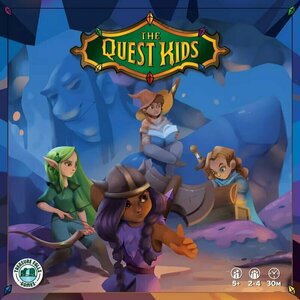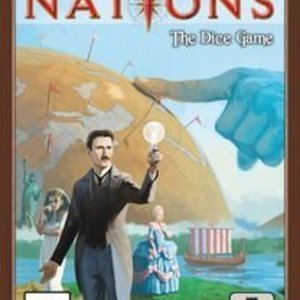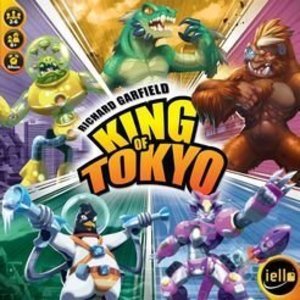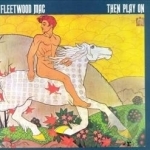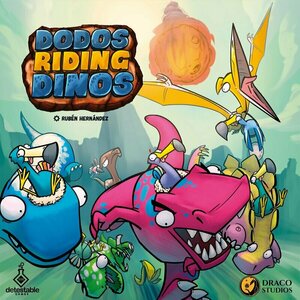Purple Phoenix Games (2266 KP) rated The Quest Kids in Tabletop Games
Mar 26, 2021
The Quest Kids is a dungeon crawler style board game for players as young as five years of age. Yes, FIVE! In it, players are acting as one of these Quest Kids, attempting to explore the cave of Tolk the Wise. The Quest Kids will find abilities to enhance their own, treasures to collect, and silly bad guys to scare away within, and the player with the most stars (VP) at the end will win the game!
DISCLAIMER: We were provided a copy of this game for the purposes of this review. This is a retail copy of the game, so what you see in these photos is exactly what would be received in your box. I do not intend to cover every single rule included in the rulebook, but will describe the overall game flow and major rule set so that our readers may get a sense of how the game plays. For more in depth rules, you may purchase a copy from the publisher online or from your FLGS. -T
To setup, place the large game board on the table and populate it with the green, gray, and red Dungeon Tiles according to the rules. Also prepare the card decks and place them appropriately in their spaces on the board. The Treasure Tokens are placed in the Treasure Bag. Each player will receive one Quest Kid Player Mat and matching figurine. In addition each player will receive three starting Health Cards, one Quest Card, and one appropriate starting Ability Card. The game may now begin from the entrance to the cave!
On a turn players will be able to have free movement around the board exploring tiles and resolving them in turns. Green tiles are always good for the players, Gray tiles may have some bad guys but are predominantly good, and Red tiles are littered with those silly bad guys that will need to be scared away. A player will travel to a board location and encounter a Dungeon Tile by flipping it over and collecting the resources shown or attempting to scare away the bad guys. Bad guys can be scared by discarding the printed Ability Cards on their tile. Once discarded, the player collects the tile to their Player Mat for stars at game end.
Sometimes players will encounter a bad guy they do not possess enough Ability Cards to scare away. In these scenarios the player may ask the other players for help. Nonactive players may then offer Ability Cards from their stash in order to help achieve the goal. For every Ability Card donated to the cause the donating Quest Kid will receive one Kind Kid Card. Kind Kid Cards are always great and can be resolved at ANY time during the game. Should a player encounter a bad guy they cannot scare away and other Quest Kids cannot help with Ability Cards, the active player will suffer a loss of one of their Health Cards (worth two stars).
Some tiles or Quest cards will instruct the player to draw one or more treasures from the Treasure Bag. Most treasures are good and provide stars, but some are blobs that eat stars. Each Treasure Token also has two values. The top value is for the normal amount of stars. However, the bottom value is worth more stars if the controlling player matches the Quest Kid printed on the token. Some treasure may be worth just one star unless the Quest Kid is a match, in which case it is then worth three stars, for example.
Turns continue in this fashion until all Dungeon Tiles have been resolved or a stalemate reached. At this point all players count up their stars they have collected from various sources and the player with the most stars is the winner!
Components. This is a kids’ game, can we all agree? THIS kids’ game, however, boasts some of the most interesting and wonderful components I have seen. The board is huge and depicts a magical cave. Super cool. The tiles are easy to read and understand, as with all the iconography. The Quest Kids themselves all have the same abilities (unless the expansion is added – and the review for that is coming soon), so that smaller children are not burdened with having to remember their special abilities. There are these plastic Tolk Gems that can be collected during the game and children absolutely flip for these things. And did you see those colorful and very big minis? I mean, come on! It’s a kids’ game! They LOVE minis! The game also comes with cardboard standees in case your children cannot handle the minis carefully enough.
Here is the deal. I absolutely adore these Quest Kids games. They are absolutely the perfect difficulty for young gamers who are ready to step up from the Candy Lands and Chutes & Ladders. Now, the box suggests 5+ but my 4-year-old did just fine with it, so take that with a grain of salt. Having had him already familiarize himself with The Quest Kids characters in The Quest Kids: Matching Adventure, this was an easier process getting this game to the table for us.
The game gives an exciting dungeon crawl experience for younger children, and it’s honestly something I never really knew I needed in my life until I now have it. It is so simple to teach and play and definitely encourages helping other players, if even just because you receive those Kind Kid cards in return. Anything to create that helpful player atmosphere to prepare them for heavier cooperative games is much appreciated.
Please do not misunderstand me. The Quest Kids is targeting younger players, but I do believe that any aged gamer could appreciate and have a good time with this. It certainly will not fill the void of other dungeon crawlers, but if you need a fix and would like to spend 20-45 minutes playing something to scratch that itch, then pull out your copy of The Quest Kids. It is super-light, colorful, and is a perfect stepping stone to bigger cooperative games. Purple Phoenix Games (with special guest Finley) gives this one a Kind 11/12. Please visit the publisher’s website to pick up your copy, and have a great time introducing your children (or partners, in-laws, grannies, pets, whomever) to cooperative dungeon crawls that will have you leaving the table in a much better mood than when you sat down.
Purple Phoenix Games (2266 KP) rated Nations: The Dice Game in Tabletop Games
Aug 16, 2019 (Updated Jul 17, 2021)
Nations: The Dice Game (can I please just call it Nations for this review as we know I am not talking about the original? Thanks.) is a civilization building, upgrade tile drafting, dice game for one to four players. Players will be upgrading their civilizations over four game rounds to compete for Books and VPs. The player with the most VP at the end of the game is the winner.
Disclaimer: The photos shown here is for a solo game, as I took them during my learning game using the solo rules. Normally the purple d4 is not used in multiplayer games. -T
To setup, each player will choose a starter civilization mat, receive five white dice, a gold chit, and a re-roll chit. Player order will be determined by cards and each player will receive their player order card which doubles as a reference card (great idea). The Progress Board will be set on the table and populated with randomized Age I Progress tiles according to the rule book. The Score Board will also be placed on the table to track Books, Events, and final VPs. The game begins with each player rolling their five dice.
Nations (TDG) is played over four ages with multiple rounds per age. At the beginning of each age old tiles will be removed from the Progress Board and new ones for the current age added. Also an Event tile will be drawn and placed on the Score Board to signify goals for Famine and War at the end of the age. On a player’s turn they will take one action from the following: Re-Roll (any or all unused dice by spending a re-roll chit), Buy tile (from the Progress Board to upgrade player mat spaces and dice), or Build Wonder (tile using Stone dice or chits for VP). When a player has taken as many turns/actions they wish for the age, they turn their player order card to the side to indicate they have passed for the remainder of the age.
Once all players have passed, they will tally their unused dice and any chits showing Books to be recorded on the Book track. Players will score points for Books based on how many opponents they have outscored for Books. Then players will consult the face-up Event tile that was revealed at the beginning of the round. The top portion displays VP earned when players discard unused dice and chits showing Famine leaf icons matching or exceeding what is on the Event tile. Similarly, for War players will consult the Event tile and use the sword icons on unused dice and chits to score any VPs for War. Play continues in this way across all four ages and once the fourth age has been scored the game ends and winner named victorious!
Components. I have mostly good news here. The dice in this dice game are wonderful. They are all easy to read and understand, and feel great when rolling nine or ten of them at once. The chits are fine, the Progress and Event tiles are nice and thick. The player mats, Score Board, and Progress Board are very thin though. I was going to give that a negative remark, but you know, players don’t really handle them during the game so there is no real need for them to be any thicker. The art is similar as in Nations, and while it does not resonate with me, it is fine. I won’t be playing Nations for the art.
All in all the game is fine. It didn’t blow me away or completely replace Nations (the big game) for me. It IS a pretty quick game to play, so there is one definite improvement over the big brother game; 10-15 minutes per player is pretty spot on. I usually do not prefer dice games to the originals (BANG! The Dice Game being the obvious improvement), and this one is really just on par with the big game. While it takes up less space on the shelf, I wouldn’t necessarily recommend it over its sibling. I feel the same way about each game, so my recommendation is get the version you feel would be played more often. Purple Phoenix Games gives Nations: The Dice Game a Montezuma-should-be-in-Age-IV 6 / 12. Give it a shot if you are into dice games, but grab the original if you want something meatier.
Rikki Hammond (33 KP) rated King of Tokyo in Tabletop Games
Jun 4, 2019
King of Tokyo is one of the first games I bought for myself, when I got back into board gaming years ago, and it's definitely a fantastic light filler game, that will appeal to all ages.
Players choose a monster, and then take it in turns rolling six custom dice up to three times (like Yahtzee,) to either attack other players, heal their own health, gain 1,2 or 3 victory points, or collect energy.
Once one player attacks another, they enter Tokyo, and gain an extra victory point for each turn they are in there, however, everyone else can attack you, and you can't heal, but your attacks hurt everyone else to counteract this. You can decide to exit Tokyo, which will put the last player who attacked you in there instead.
Energy is used to buy special cards that help you out in one way or another. This can be anything from allowing you to roll an additional die, to giving you an extra life if you are destroyed. Each card has a different energy cost to buy them, and generally the better cards cost more, although some cards cost very little, but can be very overpowered, which can throw a little imbalance in the game.
A player wins by either destroying all other monsters, or by gaining 20 victory points (although it's usually the former that occurs.)
King of Tokyo is a lot of fun, but sometimes the games can be over far too quickly, especially if someone gets lucky with the attack rolls and card purchases, and sometimes players can be eliminated early on, leaving them to sit and watch as the rest of the game is played.
Overall, I would recommend King of Tokyo to casual gamers, and those starting out in gaming, especially those with kids, as it's light, easy to teach, and fun to play.
Daniel Rossen recommended track Before the Beginning by Fleetwood Mac in Then Play On by Fleetwood Mac in Music (curated)
Johnny Haynes: Portrait of a Football Genius
Book
Johnny Haynes: Portrait of a Football Genius is the biography of one of England's greatest ever...
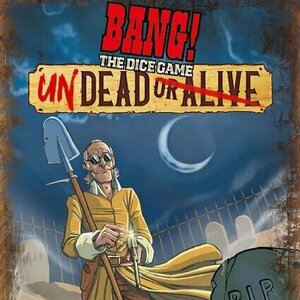
BANG! The Dice Game: Undead or Alive
Tabletop Game
BANG! The Dice Game: Undead or Alive includes five "modules" for BANG! The Dice Game that can be...
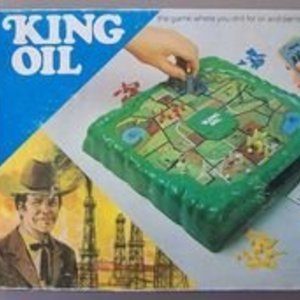
King Oil
Tabletop Game
This MB game comes with a plastic "board". Its size is dictated by the three randomizing discs...
Boardgames RetroGames
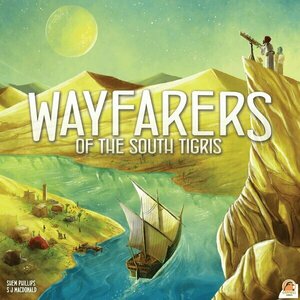
Wayfarers of the South Tigris
Tabletop Game
Wayfarers of the South Tigris is set during the height of the Abbasid Caliphate, circa 820 AD. As...
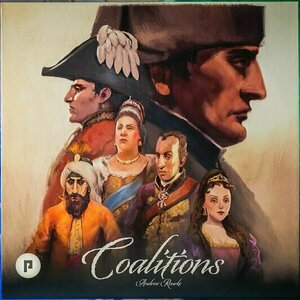
Coalitions
Tabletop Game
Coalitions is based on the series of conflicts known as the Revolutionary and Napoleonic Wars....
Purple Phoenix Games (2266 KP) rated Dodos Riding Dinos in Tabletop Games
Apr 7, 2020
Dodos Riding Dinos is a hand management, dexterity, racing card game where if while you are playing it you don’t feel like you have portaled into a prehistoric Mario Kart board game, you have missed the point.
DISCLAIMER: We were provided a prototype copy of this game for the purposes of this review. These are preview copy components, and I know the final components will be a little different from these shown (upgrades!). Also, it is not my intention to detail every rule in the game. You are invited to download the rulebook, back the game through the Kickstarter campaign beginning April 28, 2020, purchase it from your FLGS, or through any retailers stocking it after fulfillment. -T
To setup, lay out the board in the middle of the table. Randomly deal each player a Dodo/Dino team card, give them the corresponding team player dodineeple, and deal each six cards. Place the meteoreeple, eggeeple, and bananeeple (jeepers) within reach. Determine the starting player order, placing the dodineeples on the corresponding hexes behind the starting line. The game can now begin!
Dodos Riding Dinos is played over a series of rounds until one player has either surpassed the finish line or is the furthest past the finish line at the end of the round. To accomplish this, Dinos will be moved using the cards dealt at the beginning of the game and that are drawn from the deck during play. There are three colors (types) of cards: blue (normal), red (aggressive), and green (fast). During a round, players will choose a red or blue card to be played. Once all have chosen, the cards are revealed simultaneously. Whomever has the active player marker will resolve their card first, moving their dino the number shown on the top of the card and resolving any special abilities on the bottom of the card. The round will continue this way around the table until every player has resolved their card.
That is, unless two or more players have revealed red cards during the round. When this happens, these dinos are enraged and can only move, canceling out any special abilities printed on the bottom of the cards. If a red card gets through, however, get ready for the crux of the game.
Usually these cards are those that introduce the dexterity element of the game. If a card mentions throwing a banana “with a damage of 2,” then the player will grab the bananeeple, anchor their elbow to the table, and try to throw the banana onto their opponents with a wrist flick. Those that are hit will take 2 damage, where damage is discarding cards from their hand. Should a player enact a card involving throwing the eggeeple, the player will move their piece aside, place the egg there, and flick the egg to the opponents without the assistance of thumb resistance. And finally, the meteor. To unleash the meteor’s fury, the player will hold the meteoreeple in their fist, hold their arm parallel to the game board at least 1ft above the surface, and drop the meteoreeple onto unsuspecting foes causing massive damage.
Play continues in this fashion until only one player has crossed the finish line at the end of a round or the winner is the player who is furthest past the finish line when the round is over.
Components. Again, this is a prototype that was sent to us so I cannot rightfully comment on the quality of components, but I can on the art style and direction. So I really love the presentation of the components. The game is colorful, and the art is cartoony and super-quirky, a style of which I am always a fan. I’m excited to see how these components will be upgraded as a result of a successful Kickstarter campaign, but even as is, the game is gorgeous and the components are fun to handle.
It is probably no surprise that I love this one. It is super simple to learn, gives the players tons of choices per round, and perfecting the meteor drop or egg flick is going to take lots of plays, so that’s a big winner for me. I was telling the publisher that even though the box recommends ages 8+ to play, we were able to fashion some house rules to allow our 3 year old to play and have fun with it. Simply play open-handed, with no special dino abilities, and give them endless mulligans. Works for us, but the original rules are even better for adults.
So if you are a fan of games where dinosaurs are involved, or dodos, or animals riding other animals, or dexterity games, then definitely check out Dodos Riding Dinos on Kickstarter. I think that I will be backing the deluxe version because I’m a sucker for KS upgrades and content. It’s a great game as long as you don’t take yourself too seriously and just have a great time flicking eggs and meatball meeples at each other.
